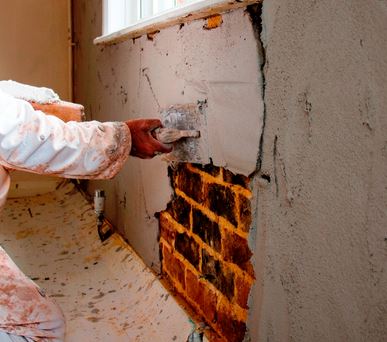The DIY Fix is reader supported. When you buy after clicking a link on our site, we may earn an affiliate commission.
 So, damp has appeared in your property. After you have identified the cause of the problem and established what type of damp it is: condensation, penetrating or rising damp, and you have chosen a suitable treatment solution, one thing you definitely want to make sure of (as much as is humanly possible) is that the damp does not reappear again. There are various things you can do to lessen the likelihood of damp returning. One such option is damp proof plaster.
So, damp has appeared in your property. After you have identified the cause of the problem and established what type of damp it is: condensation, penetrating or rising damp, and you have chosen a suitable treatment solution, one thing you definitely want to make sure of (as much as is humanly possible) is that the damp does not reappear again. There are various things you can do to lessen the likelihood of damp returning. One such option is damp proof plaster.
When should damp proof plaster be used?
Whilst using damp proof plaster offers excellent protection against the reappearance of damp, it isn’t necessary in every single case of damp. Don’t think that, regardless of the type of damp, or the extent of the damage that you should immediately start to hack off existing plaster to be replaced with a new damp proof plastering.
But, in any situation where re-plastering is necessary, you should consider using a damp proof plaster. The most common likely use for such a treatment will come in issues of rising damp.
Replastering after rising damp treatment
Most damp proof plaster products, such as the Dryzone range (probably the most popular on the market) are specifically designed for application following the insertion of a new damp proof course.
The reason why damp proof plaster is a good idea is a simple one really. Regardless of the rising damp treatment that has been carried out on a property, no treatment is able to rectify the moisture damage or salt contamination that has already been caused to existing surfaces prior to remedial treatment taking place. It is simply impossible to undo damage that is already done – that’s why replastering is a necessity.
Salt contamination is a particular problem. This usually builds up over time as a result of rising damp. The problem is often referred to as hygroscopic salts. And the reason why it is such a problem is that hygroscopic essentially means ‘moisture attracting’ – so it needs to be addressed!
Avoid the temptation to only replaster isolated affected areas. The signs of a highly salt contaminated plaster are easy to spot – it is usually clearly visible by blistering on the surface. However, light or moderate contamination will not be so obvious, and if untreated it will only cause problems in the future.
The advantages of damp proof plaster
Damp resistant or damp proof plaster is specially formulated to be particularly breathable and porous. This usually ensures that it is quicker to dry than a conventional plaster. However, the main advantage is that it is highly resistant to the transfer of damp and salt contamination.
For older buildings, a damp proof plaster designed to deal with lime and calcite (often present in heritage-type buildings) would be the most appropriate choice.
Other things to consider about damp proof plaster
Obviously, nobody wants to replaster unnecessarily. Remember, whilst highly salt contaminated walls will be clearly visible, lesser amounts of contamination won’t be. However, the best way to make the most informed decision about how much plaster needs to be replaced is to leave as long as possible (six months even) after inserting a new damp proof course before making a decision. Once the drying period is complete, it should be possible to accurately determine how much replastering might be required.
Another thing to consider is the type of plaster that is on the existing surface. For example a gypsum-type plaster typically offers less resistance to salts than a cement-type plaster. Therefore, it’s likely that if the existing plaster type is gypsum-based, the chances of salt contamination are higher.
In conclusion, although damp proof plaster is not a solution to damp in itself, it is definitely worthy of serious consideration where rising damp has been identified and treated with the insertion of a new damp proof course. Damp proof plasters are more breathable than conventional renders and they offer a higher permeability to water vapour, so they make an excellent choice when re-plastering is called for.

